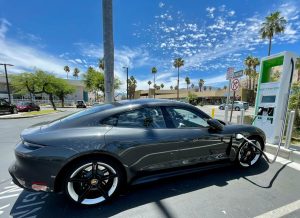
Geographically, Bangladesh is a small country in South Asia, but it has huge possibilities in different sectors. Keeping pace with the automotive world, the demand for electric vehicles in Bangladesh will rise within the next few years. Bangladesh still lacks raw materials and backward linkage. This shortage has slowed automobile manufacturing for the last three decades. However, local entrepreneurs are now preparing to enter the manufacturing sector.
In 2015, the sales of global automotive vehicles were very close to 89,000,000 US$. From 2012, analysts projected that the emerging markets would increase their share of global sales to 60% by 2020, while they also expected their share of global profits to rise by 10%. Experts anticipated that consumers would always show the strongest purchase intent in Asia.
According to the Bangladesh Road Transport Authority (BRTA) recorded data, it shows that the last year saw the registration of only 8326 trucks. Imports of reconditioned and brand-new vehicles, mostly from Japan, China, India, Korea, and a few from Europe & the US, largely dominate the automotive industry in Bangladesh. Though currently the Bangladesh EV market is almost vacant and there is a lot of business scope for EVs. There are a few initiatives to introduce EVs in the passenger car segment in Bangladesh, mostly captured by the Chinese manufacturers.
Background of the Overall Vehicle Industry in Bangladesh
Bangladesh is a developing country & its economy is a developing market economy. Bangladesh is the 39th largest in the world in nominal terms, and 30th largest by purchasing power parity; it is classified among the Next Eleven emerging market middle-income economies and a frontier market. Rapid growth enabled Bangladesh to reach the lower-middle-income country status in 2015. Sustained economic growth has rapidly increased the demand for energy, transport and urbanization. In the first quarter of 2019, Bangladesh was the world’s seventh fastest-growing economy with a rate of 7.3% real GDP annual growth.
The transport sector of Bangladesh consists of a variety of modes. The flat plain of the country encourages the widespread use of all three modes of surface transport, i.e., road, railway, and water, for carrying both passengers and cargo. People commonly use the roads and highways for transporting goods and passengers. In Bangladesh, the total length of paved roads under the Roads and Highways Department stood at more than 21,000 kilometers. As a result, road transport dominates the mobility sector in Bangladesh. Mechanized road transport moves over 70% of the country’s passengers and cargo.
Vehicle Companies in Bangladesh
Bangladesh is one of the largest markets for commercial vehicles, and importers bring all types of vehicles from abroad. Four manufacturers, namely Japanese, European, Chinese & Indian, capture the Bangladesh vehicle market. The Indian manufacturers, namely TATA, Ashok Leyland & Eichers are mostly covering the trucks market in Bangladesh. The Chinese manufacturers have a remarkable presence in the LCV & Pickup segment. Some Japanese & European manufacturers’ trucks & construction vehicles are running in Bangladesh, but those are not remarkable in quantity.
Japanese and European manufacturers mostly capture the passenger bus market for inter-city operation. European manufacturers, namely Scania, Volvo, MAN, and Mercedes-Benz, as well as the Korean brand Hyundai Universe, completely cover the luxury AC bus market. Japanese manufacturers Hino & ISUZU have a presence in this segment as well. In the non-ac bus market, Japanese manufacturer Hino is the market leader & they are capturing the largest portion of this market. In the intra-city operation, Indian manufacturers have acquired the leading position. TATA, Ashok Leyland & Eicher are covering the largest portion of the intra-city market.
Bangladesh is now a very promising market for passenger cars. The country is completing many mega projects. New roads and better infrastructure will improve cargo transport and daily travel. As a result, road communication will expand in the coming years. Therefore, the next 5 to 10 years will be very crucial for the passenger car industry in Bangladesh.
Electric Vehicles in Bangladesh
Bangladesh has moved one step forward towards implementing its plans of introducing at least 30% plug-in electric vehicles in the transportation system by 2030, with the introduction of the Electric Motor Vehicle Registration and Movement Guideline 2023. The guideline allows the import, manufacturing of EVs, two, three and four wheelers and running on the roads following registration. In addition, it will also determine its fare, route permits, economic life, etc.
According to informal estimates, Bangladesh has around 2.5 to 3 million electric three-wheelers. Bangladeshi millennials designed the PALKI CITYGLORY 2022 electric car for Bangladeshi millennials. It is an electric car that users can own, love, and use every day.
Today, “Net Zero” is a major global topic. However, the transportation sector still causes 37% of global carbon dioxide emissions because it depends on fossil fuel. As part of the global climate movement, Bangladesh has promised to cut 21.85% of national carbon emissions by 2030. It is also positive that the country produces only 0.21% of global carbon emissions, which is much lower than India. But national emissions are still growing at an average annual rate of 7.52%.
Therefore, electric vehicles can play a major role in reducing emissions. EVs emit 77.63% less carbon than fuel-based vehicles. As a result, the launch and expansion of electric vehicles can speed up Bangladesh’s journey toward a zero-carbon future.
Global EV Market
The global electric vehicle market is growing exponentially. The International Energy Agency reports that buyers purchased 6.60 million electric cars in 2021, including both BEVs and PHEVs. Sales of electric cars contributed 8.57% of global car sales of cars. The number of electric cars running on the streets globally now stands at 16.50 million units as of 2021. China alone accounted for 3.30 million units of sales and had 7.80 million electric cars running on its streets as of 2021. This impressive scenario resulted from the government’s effort to reduce carbon emissions as a part of the country’s 14th Five-Year Plan (2021-2025). In comparison, Europe sold 2.30 million electric cars in 2021, which is 65% more than the previous year.
The European market grew at a compound annual growth rate of 61% during the period 2016-2021. The proportion of electric car sales was higher in Norway, Iceland, Sweden, the Netherlands, France, Italy, and Spain than in other. As of 2021, 5.50 million units of electric cars were on the roads of Europe. In the United States, 630,000 units of electric cars were sold in 2021. The country has over 2 million electric cars on the streets. However, the US electric car market experienced a compound annual growth rate of 32% during the period 2016-21.
In some Asian countries like China, India, and Vietnam, electric two and three-wheelers have gained popularity over the years. Because of their simple manufacturing process and low operating costs, sales increased rapidly. Around 9.50 million units of electric two and three- wheelers were sold in China in 2021. 0.30 million units and 0.23 million units were sold in India and Vietnam, respectively. Sales of electric buses and trucks are relatively lower than those of cars. Electric buses and trucks accounted for only 0.30% of total sales in this segment in 2021. Globally, 4% of the buses and 0.10% of the trucks are electric variants as of 2021.
Progress of the Electric Vehicle Market in Bangladesh
The all-electric vehicle market is almost nonexistent in Bangladesh. However, the country is experiencing consistent growth in the imports of hybrid electric vehicles. A growth of 154% in hybrid car imports from 3,296 units in FY18 to 8,366 units in FY21 has been observed. Lower cost of maintenance and better fuel economy have driven the growth in sales. Hybrid variants of the Toyota Aqua, Honda Grace, and Nissan X-Trail have gained much popularity in Bangladesh. Also, there are nearly 4 million electric three-wheelers running on the streets of the country. These vehicles are known as ‘Easy Bikes’ to the masses.
Though bikes are not allowed on the streets of the capital, these vehicles have already become the primary vehicles for public passenger transportation in rural areas. Because easy bike owners use environmentally polluting lead-acid batteries and illegal electricity connections to charge the batteries, the industry is quite controversial. Also, easy bikes have safety issues due to their design. Nonetheless, the government is aiming to ensure mass adoption of electric cars by the year 2030. Through the Automobile Industry Development Policy, 2021, the government has announced its plan to undertake incentive programs to promote strategic investments with the aim of penetrating regional and global markets with locally produced electric cars. To promote local production or assembly, tax benefits have been proposed.
Manufacturers of energy-efficient vehicles will be able to enjoy a tax holiday for 10 years if they use 30% locally sourced components in the production process. A waiver of road tax and reduced registration fees will also be offered. A fund titled ‘National Energy Efficient Vehicle Production Fund’ will be created to support the industry.



